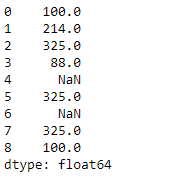Python | Pandas Series.value_counts()
Last Updated :
29 Jan, 2019
Python is a great language for doing data analysis, primarily because of the fantastic ecosystem of data-centric python packages. Pandas is one of those packages and makes importing and analyzing data much easier.
Pandas series is a One-dimensional ndarray with axis labels. The labels need not be unique but must be a hashable type. The object supports both integer- and label-based indexing and provides a host of methods for performing operations involving the index.
Pandas Series.value_counts() function return a Series containing counts of unique values. The resulting object will be in descending order so that the first element is the most frequently-occurring element. Excludes NA values by default.
Syntax: Series.value_counts(normalize=False, sort=True, ascending=False, bins=None, dropna=True)
Parameter :
normalize : If True then the object returned will contain the relative frequencies of the unique values.
sort : Sort by values.
ascending : Sort in ascending order.
bins : Rather than count values, group them into half-open bins, a convenience for pd.cut, only works with numeric data.
dropna : Don’t include counts of NaN.
Returns : counts : Series
Example #1: Use Series.value_counts() function to find the unique value counts of each element in the given Series object.
import pandas as pd
sr = pd.Series(['New York', 'Chicago', 'Toronto', 'Lisbon', 'Rio', 'Chicago', 'Lisbon'])
print(sr)
|
Output :

Now we will use Series.value_counts() function to find the values counts of each unique value in the given Series object.
Output :

As we can see in the output, the Series.value_counts() function has returned the value counts of each unique value in the given Series object.
Example #2: Use Series.value_counts() function to find the unique value counts of each element in the given Series object.
import pandas as pd
sr = pd.Series([100, 214, 325, 88, None, 325, None, 325, 100])
print(sr)
|
Output :

Now we will use Series.value_counts() function to find the values counts of each unique value in the given Series object.
Output :

As we can see in the output, the Series.value_counts() function has returned the value counts of each unique value in the given Series object.
Share your thoughts in the comments
Please Login to comment...